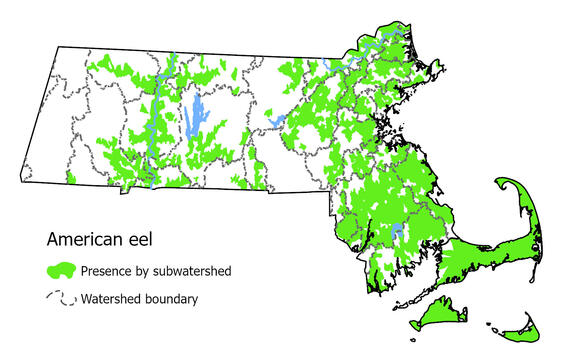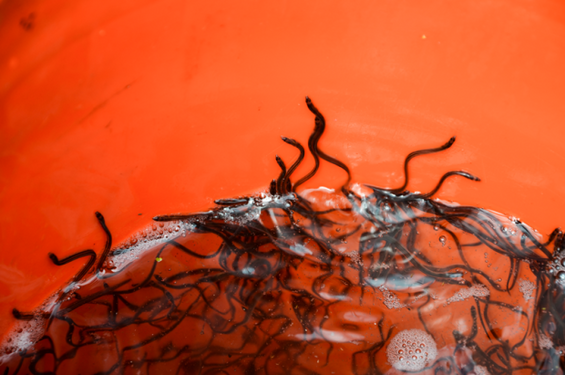- Scientific name: Anguilla rostrata
- Species of Greatest Conservation Need (MA State Wildlife Action Plan)
Description

American eel in its “yellow” stage, as an adult, with yellow and bronze pigment. Photo: Leanda Fontaine
The American eel can be identified by its elongated, snakelike body, single small gill openings, true jaws, and pectoral fins. The dorsal fin begins far behind the pectorals in the American eel, which distinguishes it from the Conger eel, Conger oceanicus, which is found in Massachusetts marine waters. Color varies in eels: at sea, larval eels are nearly transparent and colorless and, as they first assume adult shape, retain their transparency and are called "glass eels." Upon reaching freshwater, the larvae gradually develop pigment to become bronze/black on their back/dorsal surface and silver/white on their belly/ventral surface, as adults. Female American eels may grow to over 122 cm (4 ft) in length and weigh up to 7.5 kg (16.5 lbs). A 132 cm (52-inch) female, weighing 3.4 kg (7 lbs 8 oz), and with a girth of 19 cm (7.5 in), was taken on hook and line from Santuit Pond, Mashpee. Males are much smaller than females, usually 30-35 cm (12-14 in); any American eel over 40 0cm (16 in) is undoubtedly a female.
Life cycle and behavior

The American eel is a catadromous fish that spawns in the open ocean south of Bermuda. Young eels migrate to the coast; some remain in the estuaries, but many thousands migrate hundreds of miles up rivers. They live in fresh or brackish water for 7 to 20 years, consuming invertebrates, fishes, and carrion. When mature, they stop feeding and migrate back to the sea to spawn and die.
Population status
Eels appear to generally be widespread across coastal and inland waters of Massachusetts, yet their populations have declined from habitat obstructions and degradation, but little quantitative data exists regarding their population status.
The Atlantic State Marine Fisheries Commission identified American eel coastwide populations (U.S. Atlantic Coast) as “depleted”, based on a trend analysis from the 2023 benchmark stock assessment.
Distribution and abundance
American eels are common along the Massachusetts coast, as well as in ponds, rivers, and streams that are connected to the ocean. Though American eels are still common, a range-wide study by Alex Haro (Conti Anadromous Fish Research Center) and colleagues shows declines in populations between 1984 and 1995.

Data from 1999-2024 from annual surveys.
Habitat
Eels appear to be habitat generalists, surviving in a wide range of lentic and lotic environments.
Healthy habitats are vital for supporting native wildlife and plants. Explore habitats and learn about conservation and restoration in Massachusetts.
Threats
Water pollution, dams—which hinder migration—, and possibly over-fishing—particularly of the youngest “glass eels”—are the major threats to this species. It is not clear why eel stocks appear to have fallen dramatically over the past few decades, so further monitoring and research will be required to ensure that populations can be sustained.
Conservation

American eels (Anguilla rostrata)
Conserving existing eel populations is important and may be particularly impactful when combined with habitat restoration actions such as dam removal, culvert improvements, and improved water quality infrastructure (stormwater enhancements, wastewater treatment improvements).
Survey and monitoring
Eel passage is monitored at various hydropower dams that require passage through Federal Energy Regulatory Commission (FERC) licensing. Massachusetts Division of Marine Fisheries (DMF) also monitors eel populations on select coastal rivers.
Management
Improving eel passage at fish passage facilitates such as hydropower dams— particularly mainstem dam on the Connecticut and Merrimack Rivers—is an important management component. Additionally, providing eel passage over dams that currently lack passage (i.e. Chicopee River, Westfield River) is important for management and restoration.
Research needs
Research to improve safe upstream and downstream passage at select hydropower facilities is needed to prevent excess mortality and promote habitat access. A better understanding of population status in major rivers may improve management strategies.
References
This species description was adapted, with permission, from:
Karsten E. Hartel, David B. Halliwell, and Alan E. Launer. 2002. Inland Fishes of Massachusetts. Massachusetts Audubon Society, Lincoln, Massachusetts.
Contact
| Date published: | March 3, 2025 |
|---|